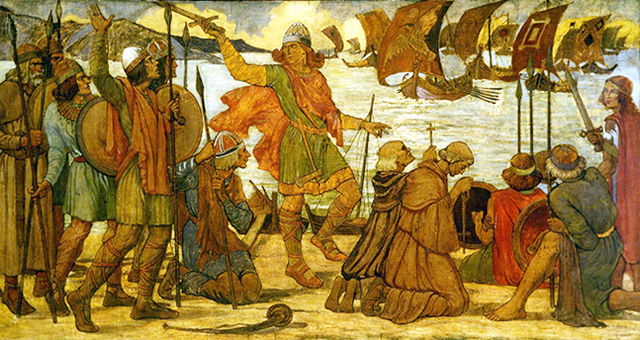Last updated on January 29th, 2023 at 08:27 pm
Perhaps one of the strangest aspects of the Viking Age of European history, which lasted from the late eighth century through to the eleventh century, was its allegedly homogenous nature.
To hear the word Viking today conjures up images of naval warriors descending into Britain, France, and Ireland from any part of Denmark, Norway, or Sweden.
Indeed, so ubiquitous is this perception that even today, we lump these countries together and perceive them as Scandinavia, even though Denmark has virtually no geographical connection to its northern neighbors and is effectively a peninsula sticking out of the top of Germany.
This raises an interesting question: How different were the Vikings who hailed from other parts of Northern Europe twelve centuries ago?
Surely those who sailed out of northern Norway’s cold, difficult fjords had a very different life than those who lived in Denmark’s much more hospitable climes? Here we explore this regional variation.

How did Vikings view themselves?
Firstly, we might ask, did the Vikings perceive themselves as coming from distinct regions or a broad region with geographical coherence?
The Vikings who raided Britain, Ireland, France, Spain, and other regions of Europe during the ninth and tenth centuries did not conceive of themselves as part of some pan-Scandinavian people.
For instance, we find in the Annals of Angoulême and the Annals of St. Bertin, two Early Middle Age chronicles, that the Norwegians involved in the sacking of the city of Nantes in the year 843 referred to themselves as ‘Vestfaldingi’, which means ‘The Men of Vestfold.’
They effectively identified themselves according to their regional area rather than being part of a ‘Viking’ or ‘Norse’ world with which modern people associate them.
There were large amounts of variations like this involved in terms of how the Vikings descended on the world. For the most part, those who were in political connection with Britain, Ireland, and northern France were sailing out of ports and communities of southern Norway and parts of Denmark, such as western Jutland and the other islands of the Danish archipelago.
It was different in the more easterly climes. In Russia and parts of Eastern Europe, and even in the Middle East, where the Arab Caliphate ruled for centuries in the Early Middle Ages, they knew the people who arrived down the Volga and Dnieper rivers as the Varangians or Rus.
The modern name for Russia comes from ‘Rus,’ which the Arabs had for what were effectively Swedish Vikings. The regional variations involved here are that these people were not coming from North Atlantic maritime communities such as are found along the coast of Norway, but more typically from the southern parts of Sweden, Gotland, and eastern Denmark.
Geography created a distinction that was recognized as far away as Baghdad. Thus, here we have a very clear situation in which the Vikings of Sweden operated differently from those of Norway or Denmark.
How Vikings changed over time
Perhaps the greatest difference between the various types of Vikings came about in the tenth and early eleventh centuries. At this time, the Vikings ruled the world of the North Atlantic, and Canute the Great was the most politically important individual in Europe. Canute became King of England in 1016, then also became ruler of Denmark in 1018, and the ruler of Norway in 1028.
What is striking about this is that while Canute was the most powerful monarch in Europe of his day, other than the Holy Roman Emperor in Germany, he had no influence over the vast majority of Sweden.
The Vikings who lived along the shore of the Gulf of Bothnia in eastern Sweden did not live in the same world as the Danes of Canute’s North Atlantic empire, or what has sometimes been referred to as the North Sea Empire.
Indeed this form of territorial differentiation pervades the history of the Vikings. There are almost no examples of Swedes or eastward Danes conquering parts of the North Atlantic world. Those who did make an impression in these regions generally sailed out of ports or fjords which faced the Atlantic.
For instance, Erik the Red, who led the first Norse expedition across the Atlantic and established a settlement on Greenland, came from Rogaland in southwestern Norway. Thereafter his ancestors established a greater presence in the North Atlantic world by moving further westwards.
Erik’s son, Leif, believed to have been the first European to make contact with continental America, was born in Iceland and moved further westwards in his lifetime.
Moreover, there were large amounts of cultural variations involved, the most notable being in terms of dress, as the climate of northern Norway is very different from that of Denmark or southern Sweden.
What all of this should make clear is that the world of the Vikings was not culturally homogenous. The Vikings who sailed out of ports in northwestern Norway and colonized Iceland were very different from those who emerged from southern Sweden and moved down the riverine routeways of Europe to the Black Sea and the Caspian Sea.
They had a certain amount of cultural similarities regarding their religion, social structure, and various other aspects of their politics and economy. Still, there was a considerable difference between the Dane of Jutland, the Norwegian of Trondheim, and the Swede of Gotland.


“….Scandinavia, even though Denmark has virtually no geographical connection to its northern neighbors and is effectively a peninsula sticking out of the top of Germany.” It needs to be understood that these countries were in fact connected by sea. The entire Baltic Sea was a fluctuating petri dish of cultures. As an example, my DNA shows Swedish, Finnish and German combination.